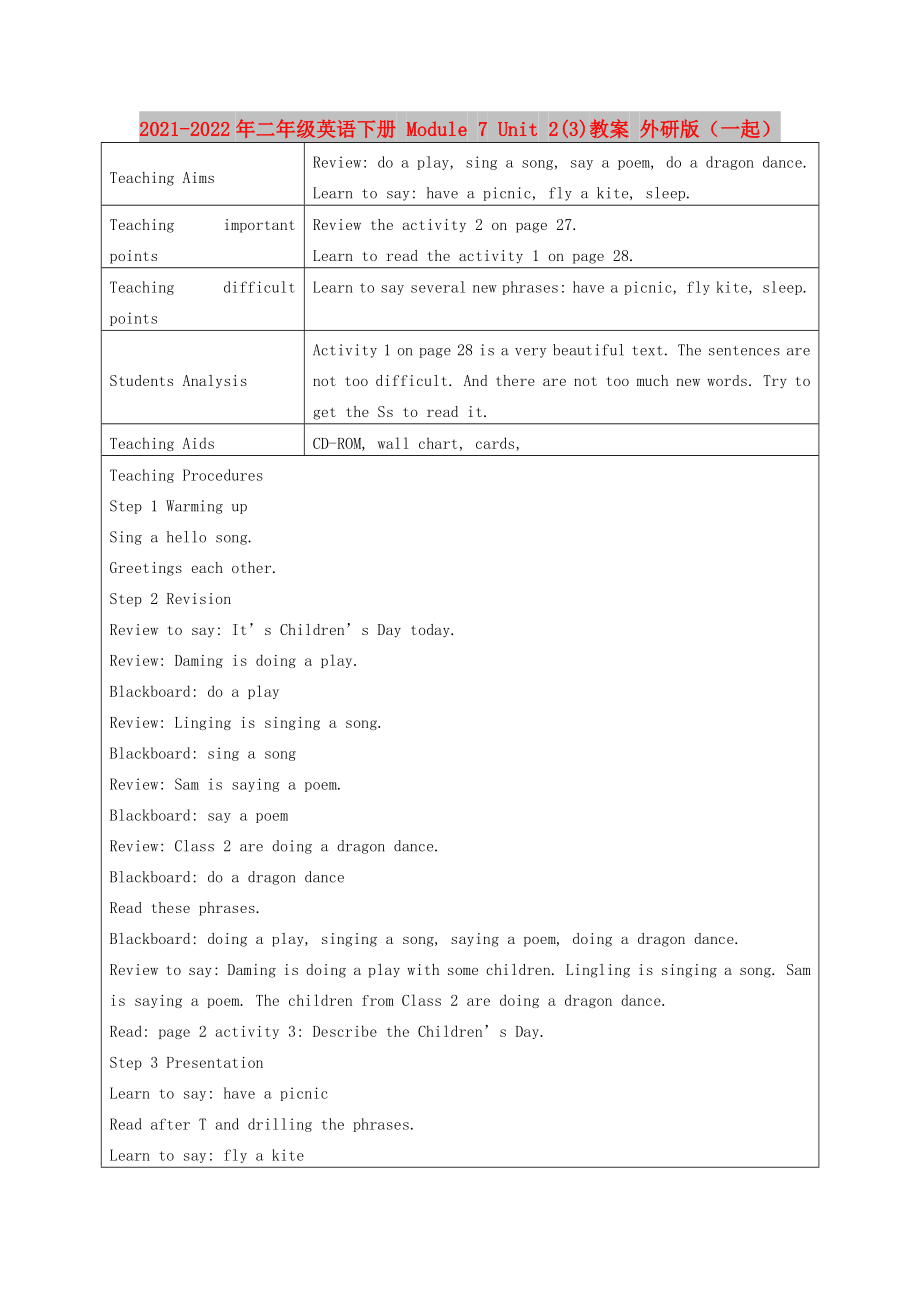《2021-2022年二年級(jí)英語下冊(cè) Module 7 Unit 2(3)教案 外研版(一起)》由會(huì)員分享�,可在線閱讀,更多相關(guān)《2021-2022年二年級(jí)英語下冊(cè) Module 7 Unit 2(3)教案 外研版(一起)(3頁珍藏版)》請(qǐng)?jiān)谘b配圖網(wǎng)上搜索�。
1、2021-2022年二年級(jí)英語下冊(cè) Module 7 Unit 2(3)教案 外研版(一起)
Teaching Aims
Review: do a play, sing a song, say a poem, do a dragon dance.
Learn to say: have a picnic, fly a kite, sleep.
Teaching important points
Review the activity 2 on page 27.
Learn to read the activity 1 on page 28.
Teaching difficult p
2���、oints
Learn to say several new phrases: have a picnic, fly kite, sleep.
Students Analysis
Activity 1 on page 28 is a very beautiful text. The sentences are not too difficult. And there are not too much new words. Try to get the Ss to read it.
Teaching Aids
CD-ROM, wall chart, cards,
Teaching
3����、 Procedures
Step 1 Warming up
Sing a hello song.
Greetings each other.
Step 2 Revision
Review to say: It’s Children’s Day today.
Review: Daming is doing a play.
Blackboard: do a play
Review: Linging is singing a song.
Blackboard: sing a song
Review: Sam is saying a poem.
Blackboard: say
4��、a poem
Review: Class 2 are doing a dragon dance.
Blackboard: do a dragon dance
Read these phrases.
Blackboard: doing a play, singing a song, saying a poem, doing a dragon dance.
Review to say: Daming is doing a play with some children. Lingling is singing a song. Sam is saying a poem. The chil
5���、dren from Class 2 are doing a dragon dance.
Read: page 2 activity 3: Describe the Children’s Day.
Step 3 Presentation
Learn to say: have a picnic
Read after T and drilling the phrases.
Learn to say: fly a kite
Read the phrase and drilling it.
Learn to say: sleep
Distinguish: sleep, sleeping.
6����、
Game: Listen and point (left, right, up, down)
Watch the CD-ROM: page 28: activity 1
Understand the text and repeat it after T.
Try to read the text together.
附送:
2021-2022年二年級(jí)英語下冊(cè) Module 8 Unit 1(1)教案 外研版(一起)
【模塊建議】
教 學(xué)
主 題
Positions
模塊第一單元通過描述火車位置的小故事���,學(xué)習(xí)描述方位的介詞up, down, pas
7���、t, at等����。模塊第二單元?jiǎng)t通過做TPR活動(dòng)來鞏固所學(xué)的描述方位的詞語��。
語 言
功 能
Following routes.
教
學(xué)
目
標(biāo)
語言
知識(shí)
目標(biāo)
1. Target Lanuage:
The train is going up the hill. (down a hill/ past a hospital).
We are going up/ down.
We are turning round.
2. Vocabulary:
up, hill, station, down, past
8����、, hospital, stop, see, turn, around, touch.
3 Song: Shake, shake.
語言
能力
目標(biāo)
1. Students can grasp the words in this unit.
2. Students can describe the positions correctly.
學(xué)習(xí)
策略
目標(biāo)
1 對(duì)所學(xué)習(xí)內(nèi)容能主動(dòng)練習(xí)和實(shí)踐
2 嘗試探索����、總結(jié)現(xiàn)在進(jìn)行時(shí)句子的結(jié)構(gòu)特點(diǎn)。
文化
意識(shí)
目標(biāo)
通過學(xué)習(xí)對(duì)London的交通狀況有所了解��。
【熱身和導(dǎo)入】
Chant:1. Where i
9��、s my pencil? ( in on under)
2. Up, down, cross.
3. Sing a song. ( Walking. )
Review the knowledge we have learned and prepare for today’s new knowledge.
【任務(wù)呈現(xiàn)】
1 Listen and say the target sentences.
2 Pair works and show.
3 Let students express position themselves.
10�����、
【任務(wù)準(zhǔn)備】
1. Listen and follow the rote with your finger, then point and say.
2. Describe your own rote then let your partner draw.
3. Summary: Review the sentences they’ve learned today.
4. Let the students be clear about all positions.
【任務(wù)完成】
Activity book Page 30 (1) Listen and number. Page 33 ( 3 ) Look and write.
【家庭作業(yè)】
Listen and practice the dialogue with your partner.
Make up dialogue, using up, down and cross.
If possible draw your own rote and describe it correctly.
 2021-2022年二年級(jí)英語下冊(cè) Module 7 Unit 2(3)教案 外研版(一起)
2021-2022年二年級(jí)英語下冊(cè) Module 7 Unit 2(3)教案 外研版(一起)

